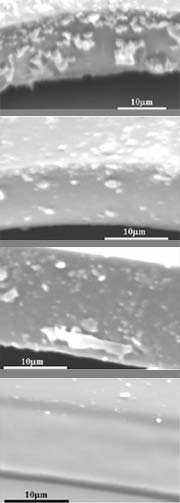Combinatorial techniques yield polymer libraries to expedite materials testing and design

SEM micrographs of fracture surfaces at various impact sites from high-throughput mechanical screening on a composition-gradient library of polyurethane urea
Today’s advanced materials have become extremely complex in chemistry, structure and function, which means scientists need faster, more efficient ways to model and test new designs.
J. Carson Meredith, an assistant professor of chemical and biomolecular engineering at the Georgia Institute of Technology, has pioneered combinatorial synthesis and high-throughput screening in polymer science – techniques that allow researchers to create and evaluate thousands of polymeric materials in a single experiment. On April 1 at the American Chemical Society’s 227th national meeting in Anaheim, Calif., Meredith will present recent advances in biomedical and electronic polymers.
Meredith began his research in 1998 while working on a new biomaterial at the National Institute of Standards and Technology. At that time, measuring biological and mechanical properties of polymers was an expensive and time-consuming task.
“As we thought about it, we realized the number of experiments we’d have to run was too large,” Meredith recalled. “So we took a step back and asked, ’What if we could test 1,000 samples at once?’ ”
Inspired by combinatorial methods used in drug discovery, Meredith developed a technology for depositing large collections of polymers on a single microscope slide, using property gradients to create thousands of variations in composition, temperature and thickness.
These polymer libraries dramatically reduce the time and effort required to develop new materials. What’s more, statistical reliability is increased when taking measurements under the same environment.
“In contrast, with a traditional one-sample-per-one-measurement approach, you run the risk of not fully optimizing the material,” Meredith said. “Or you could completely miss the material you wanted to find in the first place.”
Since joining Georgia Tech in 2000, Meredith has been applying his technologies to develop new materials in the biomedical and electronic arenas.
“Biomedical materials are especially challenging to design because they must be compatible with the human body,” Meredith explained. “Yet the physical surface of polymers can affect the attachment and function of biological cells.”
Achieving control over cellular interaction with synthetic surfaces will open new doors in biomaterials, such as engineering artificial tissues that are alternatives to organ transplants or deliver drugs only to diseased cells.
Collaborating with Andrés García in Georgia Tech’s Woodruff School of Mechanical Engineering, Meredith has already developed a technique for growing bone cells on polymer libraries and discovered a unique polymer formulation that causes optimal function.
“By changing the physical microstructure of the polymer, you can achieve large changes in how biological cells respond,” Meredith explained. “The polymer libraries allow us to pinpoint very accurately the precise composition that works.”
Meredith’s research team is also working on cardiovascular biomaterials for artificial blood vessels. “It’s difficult to get cells that line the arteries to grow correctly on a synthetic material,” Meredith said. “We have to fool them into believing they’re inside a real artery instead of a plastic tube.”
Beyond biomedicine, Meredith is also using combinatorial synthesis and high-throughput screenings to develop new electronic materials.
His research team is working on a technology to manufacture polymeric computer chips. Because polymers are flexible, they offer superior mechanical properties for electronic components in contrast to traditional silicon, which is hard and brittle.
Yet at nanoscale thicknesses, getting these thin films to adhere to each other has been a major challenge. Using the polymer libraries, the researchers have discovered that the ability of an insulator film to coat a semiconducting polymer is a strong function of thickness. “Now we’re exploring what thickness will provide the optimal material,” Meredith said.
Critics may deem combinatorial techniques a shotgun approach, but it’s hardly a random process, said Meredith, who uses predictive models and previous data to help select material combinations to screen.
And discovering a winning polymer is only part of the equation. It’s critical to mine all the data and then explain scientifically why some materials work and others don’t, he noted.
“We’ve been surprised by how much the libraries tell us, especially in case of biomaterials,” Meredith said. “This knowledge creation is just as important as the materials development side.”
Technical Contact:
Carson Meredith, 404-385-2151 or carson.meredith@chbe.gatech.edu
Media Contact
More Information:
http://gtresearchnews.gatech.edu/All latest news from the category: Materials Sciences
Materials management deals with the research, development, manufacturing and processing of raw and industrial materials. Key aspects here are biological and medical issues, which play an increasingly important role in this field.
innovations-report offers in-depth articles related to the development and application of materials and the structure and properties of new materials.
Newest articles

Durable, Efficient, Sustainable: The Rise of Cerium Oxide Thermal Switches
Groundbreaking cerium oxide-based thermal switches achieve remarkable performance, transforming heat flow control with sustainable and efficient technology. Cerium Oxide-Based Thermal Switches Revolutionize Heat Flow Control Thermal switches, which electrically control…

How Industrial Robots are Reducing Emissions in Global Manufacturing
A new study explores the intersection of industrial automation and environmental sustainability, focusing on the role of industrial robots in reducing the carbon intensity of manufacturing exports. The research demonstrates…

Patients Can Heal Through Precise, Personalized Bioceramic Grafts
A recent review is transforming the landscape of craniomaxillofacial bone regeneration with the introduction of personalized bioceramic grafts. This pioneering research explores the fabrication and clinical potential of synthetic grafts…



